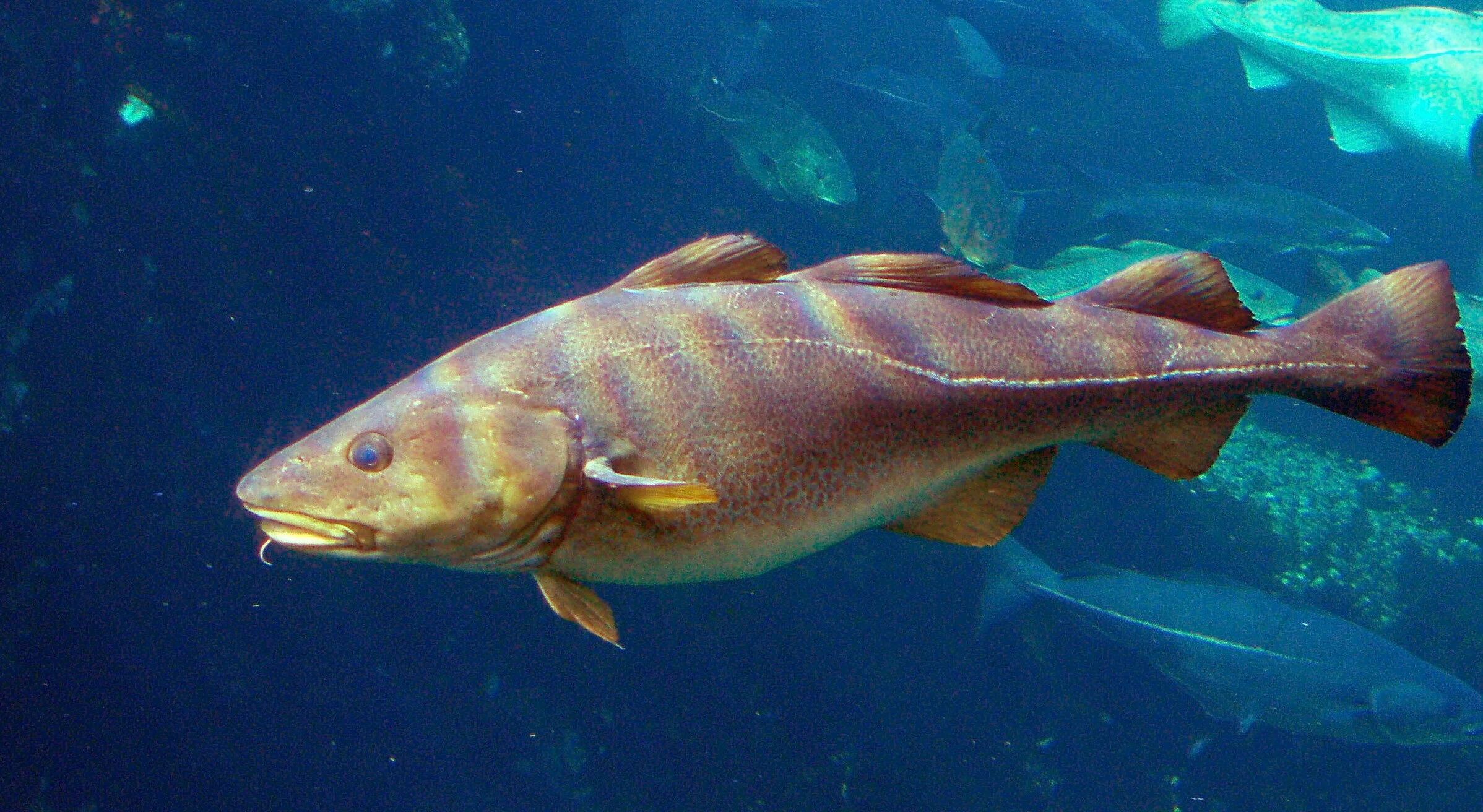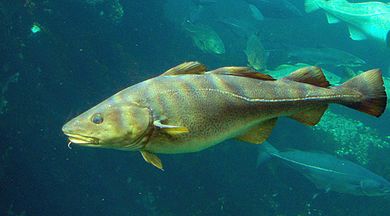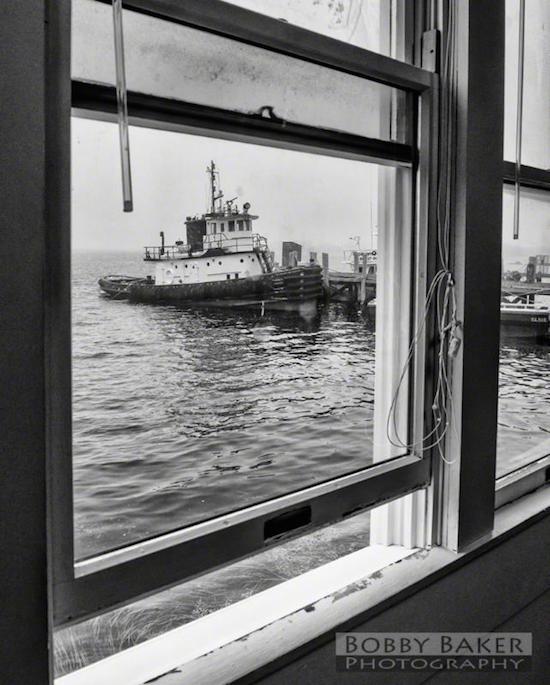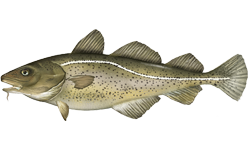
When you could get in cheap
Atlantic cod
— Photo by Hans-Petter Fjeld
“By 1937, every British trawler had a wireless, electricity, and an echometer - the forerunner of sonar. If getting into fishing had required the kind of capital in past centuries that it cost in the twentieth century, cod would never have built a nation of middle-class, self-made entrepreneurs in New England.”
― From Mark Kurlansky’s Cod: A Biography of the Fish that Changed the World
Vessel traffic screwing up cod communication
Atlantic cod.
Via ecoRI News (ecori.org)
National Oceanic and Atmospheric Administration (NOAA) scientists studying sounds made by Atlantic cod and haddock at spawning sites in the Gulf of Maine have found that vessel traffic noise is reducing the distance over which these animals can communicate with each other. As a result, daily behavior, feeding, mating and socializing during critical biological periods for these commercially and ecologically important fish may be altered, according to a study recently published in Nature Scientific Reports.
Three sites in Massachusetts Bay, two inside the Stellwagen Bank National Marine Sanctuary (SBNMS) and one inshore south of Cape Ann, were monitored for three months by researchers at the Northeast Fisheries Science Center (NEFSC) laboratory in Woods Hole, Mass., and at the sanctuary offices in Scituate, Mass. Vocalizations, such as Atlantic cod grunts and haddock knocks, were recorded by bottom-mounted instruments at each site during spawning in winter and spring.
“We looked at the hourly variation in ambient sound pressure levels and then estimated effective vocalization ranges at all three sites known to support spawning activity for Gulf of Maine cod and haddock stocks,” said Jenni Stanley, a marine research scientist in the passive acoustics group at the NEFSC and SBNMS and lead author of the study. “Both fluctuated dramatically during the study. The sound levels appear to be largely driven by large-vessel activity, and we found a signification positive correlation with the number of automatic identification system (AIS) tracked vessels at two of the three sites.”
AIS is an automatic tracking system, used on ships and by vessel-traffic services. It provides information on a vessel, such as its unique identification number, position, course, and speed, which can be displayed on a shipboard radar or electronic chart display.
Ambient sounds — those in the surrounding environment — include animals vocalizing, physical sounds such as wind and water movement or geological activity, and human-produced sound from ships and marine construction. Many marine animals use ambient sound to navigate, to choose where to settle, or to modify their daily behaviors including breeding, feeding, and socializing.
Cod grunts were present for 100 percent of the spring days and 83 percent of the winter days. Haddock knocks were present for 62 percent of the winter days within the three-month sampling period. However, ambient sound levels differed widely at the three sites, both on an hourly and daily time scale. The Atlantic cod winter spawning site, nearest the Boston shipping lanes, had the highest sound levels, while the Atlantic cod spring spawning site inshore south of Gloucester, Mass., had the lowest. Sound levels in the haddock winter spawning site, further offshore in the sanctuary, were in the middle of the range detected in the study.
Study data were also used to calculate the estimated distance a fish vocalization would be heard at each of the spawning sites. The effective radius ranged widely, from roughly 4 to 70 feet, and was largely dependent on the number of tracked vessels within a 10-nautical-mile radius of the recording sites.
Lower-level, chronic exposure to increased ambient sound from human activities is one of the most widespread, yet poorly understood, factors that could be changing fish behavior, according to researchers. If they can’t hear as well as they need to, then sound signals from other fish can be lost, compromised, or misinterpreted in ways that can cause a change in behavior. Since Atlantic cod, for example, vocalize to attract mates and listen for predators, not hearing those signals could potentially reduce reproductive success and survival.
“Anthropogenic sound in certain ocean regions has increased considerably in recent decades due to various human activities such as global shipping, construction, sonar, and recreational boating,” Stanley said. “As ocean sound increases, so does the concern for its effects on populations of acoustic signalers, which range from invertebrates to marine mammals. We don’t know if or to what extent specific species can adapt or adjust their acoustic signals to compete in this environment.”
No quotas, no fish
An Atlantic cod.
From Robert Whitcomb's "Digital Diary, '' in GoLocal24.com:
No fishing regulations, no fish. It’s good to remember that when reading the news that the National Oceanic and Atmospheric Administration has ordered around 60 fishermen and 22 vessels, mostly out of New Bedford, to return to shore as a result of cheating on fishing catches of cod, haddock, flounder and some other ground fish. The owner of many of the boats, Carlos Rafael, aka “The Codfather,’’ has been convicted in federal court of massive fishing violations.
The fishermen haven't been keeping accurate counts of their catches: Translation: They’ve been cheating on the quotas meant to protect the viability of valuable species in the waters off New England. The cod population is under particular pressure, with surveys saying that it has fallen to about 6 percent of what’s needed for long-term sustainability.
We almost made the American bison (buffalo) extinct by acting for decades as if they were inexhaustible. We sometimes seem to be taking the same attitude toward fish in the sea. Anyway, this is bad news for New Bedford for the next couple of year
Cod and science vs. anecdote
Adapted and expanded from an item in Robert Whitcomb's "Digital Diary'' in GoLocal24.com
The decline of cod, presumably New England’s most famous fish, is a prime example of why we need government oversight of certain species. In the “tragedy of the commons,’’ fishermen will almost always take the short view and maximize profits by taking out of the sea as many fish as they can as fast as they can.
For years fishermen have complained that federal rules aimed at preserving cod stocks through fishing bans or tight limits on catches are based on faulty science and conflict with fishermen’s (anecdotally based) observations. Well, that science was pretty damn good but Massachusetts Gov. Charlie Baker, in response to complaints from the industry, much of which is based in Gloucester, ordered the state to do its own survey.
The chief finding: Cod populations have been plunging in the Gulf of Maine, with stocks down about 80 percent from a decade ago. For political reasons, Mr. Baker would have preferred a more upbeat report that avoided offending a local industry as he goes into a re-election campaign next year.
The fish are disappearing, partly from overfishing and, probably, partly from global warming. (Consumers can help by not ordering cod.) Also perhaps playing a big role is the reduction in the species' food supply, suggests my businessman friend Stephen Key, who has been in various parts of the food sector for years. All of that increased commercial fishing for bunker/menhaden (used for fish-oil pills etc.), must have an impact, and not just on cod.
The fact is that there are times when only government can save species. Consider the role of the Feds, under President Theodore Roosevelt, in stopping what seemed to be the imminent extinction of the American bison (aka buffalo) by trophy and meat hunters.
Raising tuna at URI
These yellowfin tuna are schooling in the ocean. Other yellowfin tuna are schooling in a giant tank at URI's School of Oceanography. It's exciting to watch.
Expanded from an item in Robert Whitcomb's Dec. 31 '"Digital Diary'' column in GoLocal24.com
Thank God for scallops. These shellfish have been a boon for New England fishermen– an offset to the tendency of fishermen to fish to near-extinction finfish, such as as cod, off New England to meet the world’s rapidly growing appetite for seafood.
But there may soon be big reinforcements for New England's fishing sector and they start on land. Experts in a facility on the campus of the University of Rhode Island School of Oceanography are raising yellowfin tuna in an exciting and potentially very lucrative aquaculture experiment. I recently had a tour of the URI Bay Campus facility, which has a giant tank where this is taking place. To see the tuna school in the tank is, well, neat.
If this experiment works, it could mean a lot of money for URI and for businesses, based, let us hope, in New England. Most of the aquaculture in southern New England has been with shellfish; there's been some salmon aquaculture in Maine. It’s nice to see more diversification.
Peter Baker: Illegal N.E. fishing hurts future stocks
"Outside My Window'' (Woods Hole, Mass.), copyright Bobby Baker Photography.
An aromatic site.
This article comes courtesy of ecoRI News
BOSTON
We’ve seen a rash of stories recently on illegal fishing in the Northeast, as enforcement officials take action on unreported catch. Some of the numbers are eye-popping. One bust involved 56,000 pounds of illegally caught and unreported summer flounder, also known as fluke. Another charge alleged 86,000 unreported pounds of the same fish over three years.
Research indicates that those figures are no fluke — pardon the pun. In fact, these recent incidents represent only a small fraction of illegal and unreported catch. Studies show that most illegal fishing in the region involves cheating on rules regarding the amount, type or size of fish allowed to be caught, misreporting in dealer reports, or fishing in places set aside to protect fish habitat and spawning areas. Few people realize the extent of illegal fishing, the harm it can do to ocean resources, and the ways in which this cheating undermines efforts to measure and sustainably manage fisheries.
For example, a study published in the journal Marine Policy in 2010 estimated that 12-24 percent of New England’s total catch of groundfish — bottom-dwelling fish such as cod, flounder and haddock — was taken illegally. How much fish is that? Well, when the authors took the midpoint of that estimate (18 percent) and applied it to the actual landings from the time the study was conducted, they found that the illegal catch would amount to more than 11 million pounds of fish, worth about $13 million.
And what if those illegally caught fish had instead been left in the water where they could grow and reproduce? The researchers give an estimate of that loss, too. Over five years those fish could have contributed some 65 million pounds to the overall biomass of the groundfish stock. That extra supply would be a welcome bounty today, when many groundfish populations are so low that the fishery has been declared a federal disaster, requiring tens of millions of dollars in taxpayer assistance.
Fisheries managers are responding to some problem areas. In the mid-Atlantic, for example, officials recently suspended use of a controversial “set-aside” program that had allegedly been exploited to hide catch that exceeded quotas. New England’s fishery managers have started looking into reports of vessels employing net-liners and other fishing-gear modifications that result in fish being caught under the legal size limit.
This “missing catch” from illegal fishing also complicates the work of scientists and managers who need an accurate picture of what’s really happening on the water. The actual mortality, or amount of fish killed, is a key piece of information for estimating fish populations and setting sustainable fishing levels.
The Marine Policy study found that even commercial fishermen assume that about 10 percent to 15 percent of their colleagues are routinely breaking the law. The researchers say that the odds of getting caught are slim, while the payoff from cheating is “nearly five times the economic value of expected penalties.”
All this illicit activity takes a toll on those fishermen who do follow the rules. The researchers surveyed fishermen and discovered that many believe that illegal fishing “will prevent them from ever benefiting from stock rebuilding programs.” This finding underscores one of the greatest damages. Hardworking fishermen who do the right thing as stewards of the public resource are cheated of their just reward of higher catches in the future. Although enforcement may be unpopular to some, it is critical for any well-managed fishery.
Peter Baker directs The Pew Charitable Trusts’ U.S. ocean-conservation efforts in the Northeast and Mid-Atlantic.
Peter Baker: Restore the prey of cod to restore cod
(See this excerpt from a Portuguese documentary about cod fishing.)
A recent study illustrates what has happened to New England’s once plentiful Atlantic cod population, and the findings highlight the big role that little fish play in our marine ecosystems and economy. It’s no secret that New England’s cod are in trouble. Overfishing has so severely depleted the population that federal officials declared a fishery disaster and Congress appropriated more than $30 million in aid. But even as the bottom fell out of cod stocks, many fishermen insisted the fish were still plentiful in their nets and disputed the science supporting tighter catch limits. Why did fishermen see a bounty while scientists in fact called it a bust? Researchers at the National Oceanic and Atmospheric Administration’s Northeast Fisheries Science Center say a change in the forage fish, or small prey species, the cod were eating offers an explanation. In an article published in May in the Canadian Journal of Fisheries and Aquatic Science, the authors say that around 2006 the dominant prey for cod switched from Atlantic herring to sand lance — small, eel-like fish that burrow in the sediment of the seafloor. Sand lance were abundant in an area known as Stellwagen Bank, and so cod, too, congregated there. Soon, cod fishermen focused so much effort on the bank that some 45 percent of the cod caught in a year came from just a 100-square-mile area in the region. But scientific surveys assessing the cod population over more than 20,000 square miles in the Gulf of Maine continued to show that the larger population was seriously depleted. Clearly, the abundance in one small region didn’t accurately reflect the overall status of cod. The authors say they hope that the findings can “help fishery managers, scientists and the industry understand and resolve apparent conflicts between assessment results and the experiences of the fishing industry.” While this study helps to explain the recent past, it also holds important lessons for the future of fishing. The switch in cod diet from herring to sand lance held major implications for one of the region’s most important fish. Over the years, through intensive fishing for prey species such as Atlantic herring and menhaden, plus the depletion of other historically important prey such as river herring and shad, the “menu” of forage fish available to cod and other predators has changed. We need a management system that better monitors and responds to the ways prey and predators interact. Such a system is available, and it’s called ecosystem-based fisheries management. Scientists have long known that simply measuring and managing one fish species at a time is insufficient. So they’ve put decades of work into developing the ecosystem-based approach to provide a much more accurate and useful picture of what’s occurring in the water. A good ecosystem-based fisheries management program would take the needs of predator species into account and let managers restore the abundance of prey, causing a resurgence of fish stocks and, ultimately, providing greater opportunity for the fishermen who depend on them.
Peter Baker directs the Pew Charitable Trusts’ U.S. ocean conservation efforts in the Northeast and Mid-Atlantic. This piece originally appeared on ecori.org.









